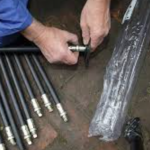Showering is one of the most common daily activities for many people. However, if you have a leak in your tub, it can be quite annoying to deal with and it can cause damage to your property. But don’t worry; this blog article will help you find out the best way to fix a tub leak no matter what type of water is coming from the faucet.
What are the causes of bathtub leaks?
There are a few common causes of bathtub leaks, including defective seals around the tub and shower enclosure, worn out gaskets and loose hardware, incorrect installation or maintenance procedures, and inadequate drainage. In some cases, a bathtub may simply be too small or deep for the amount of water that is being used, resulting in water spilling onto the floor. Additionally, improper installation or use of caulking or sealant can also contribute to bathtub leaks. If you notice your bathtub is leaking and you don’t know why, it’s important to contact a professional to inspect the situation and determine the best course of action. You can learn to remove yellow condensation stains on ceiling.
How to prevent bathtub leaks in the shower
If you have a leaky bathtub in your shower, there are a few things you can do to prevent it from happening again. Follow these tips and you’ll be able to enjoy your shower without worrying about water spilling onto the floor.
1. Check the caulking around the tub and around the shower head for signs of wear or damage. If there’s sign of leakage, replace the caulking as needed.
2. Make sure the showerhead is properly installed by checking for leaks at the stem, elbow and clamping mechanisms. If there are any leaks, replace the showerhead.
3. Inspect the hoses and connections for signs of kink or damage. If there are any issues, tighten or replace them as necessary.
4. Clean the bathtub and surrounding surfaces regularly with a mild cleaner to remove built-up soap scum and other debris that can obstruct water flow. Be sure to rinse off all residues before taking a bath or shower.
Steps to take when you experience a shower leak
If you’re noticing water spilling out of your shower or tub all the time, there are a few things you can do to troubleshoot and fix the problem. Here are four steps to take:
1) Check the caulking on the shower or tub trim. This is probably the first place that water gets behind and causes the leak. If the caulk is old, brittle, or missing, replace it with a new sealant.
2) Inspect the showerhead for proper installation. Many times a showerhead won’t fit correctly and can cause water to flow backwards or outward instead of downwards. Replace a faulty showerhead if necessary.
3) Check for any leaks around the base of the tub or shower. Water can seep underneath the tile and cause a leak. Fixing this type of leak often requires replacing the flooring as well.
4) Finally, inspect all of your plumbing for any damage or obstructions that may be preventing water from flowing freely. This includes checking for clogs in your drains and broken hoses. If everything looks OK, then you may need to call a professional to fix your shower or tub leak.
Tips for fixing bathtub leaks when shower is on
If your shower leaks, here are some tips to help fix the problem:
1. Check the hoses and connections: Make sure all of the hoses and connections that go into the shower are tightly sealed. If there is a leak, it may be due to a faulty hose or connection.
2. Repair any damage: If there is water damage inside or outside of the shower, you may need to repair it before you can fix the leak. This includes fixing any cracked tiles, broken seals, and missing/worn parts.
3. Replace any damaged parts: If there is an underlying cause of the leak (e.g., a faulty valve), you may need to replace certain parts in order to fix the issue. Consult with a professional if you have any doubts or questions about the repairs needed. Let’s learn how to wash clothes in bathtub.
Conclusion
There are a few things you can do to help prevent your bathtub leaks when shower is on. First, be sure to tighten the bolts that attach the wall to the bottom of the tub. Second, make sure that the shower is level and plumb by checking for any tilting or cockeyed walls. Finally, check for any cracks in the tile or mortar near the drain where water could seep underneath. If you find any of these problems, take action to fix them as soon as possible so that your shower doesn’t become a source of leaks and trouble!














